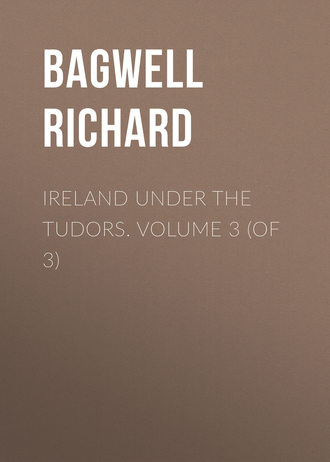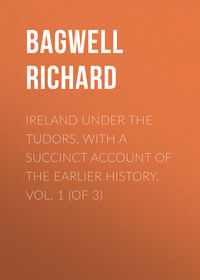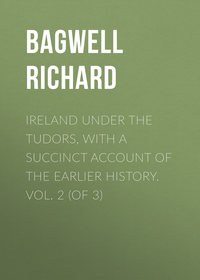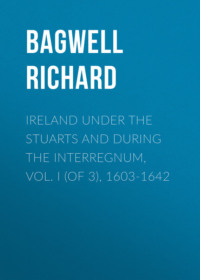 полная версия
полная версияIreland under the Tudors. Volume 3 (of 3)
223
O’Sullivan, tom. iii. lib. 2, cap. 7; Four Masters, 1593; Shirley’s Monaghan, pp. 97 and 98; the Earl of Tyrone’s grievances, March 14, 1594.
224
Fenton to Burghley, Feb. 2, 1594; Captain John Dowdall to Fitzwilliam, Feb. 2, 3, and 7; Bingham to Puckering, C.S., Feb. 15; Cornelius Maguire to Fitzwilliam, Feb. 7; O’Sullivan, tom. iii. lib. 7, cap. 7.
225
Fitzwilliam to Burghley, Jan. 30, 1594; to Cecil same date; Ormonde to Burghley, Feb. 20; Tyrone to Bagenal, Feb. 17; declaration of Darby Newman, Feb. 19; draft minute by Burghley and others concerning the viceroyalty, March.
226
Tyrone’s grievances, March 14, 1594; Tyrone to Wallop, April 3; Bagenal to Fitzwilliam, March 20; Ormonde to Tyrone, May 21.
227
Fitzwilliam to Burghley, Feb. 28 and April 19, 1594; Bagenal to Fitzwilliam, March 20. Lee’s declaration to the Queen is printed (with some obvious mistakes) in Desiderata Curiosa Hibernica, vol. i. pp. 89 to 150. It was written in England between Oct. 1594 and March 1596, as is proved by the references to Sir Robert Gardiner’s movements. Lee was of Reban castle near Athy, where he had property.
228
Ormonde to Tyrone, April 19 and 30, and May 21, 1594; Tyrone’s answer to the letter of April 30; Burghley to Ormonde, April 7; Carew to Burghley, April 13.
229
Florence MacCarthy’s Life.
230
Russell to Cecil, Aug. 16, 1594, and to the Privy Council, Aug. 17; Ormonde to Burghley, Aug. 19; Russell’s Journal in Carew, June to August.
231
Submission and answers of Tyrone, Aug. 15 and 17, 1594; informations preferred by Sir Henry Bagenal, Aug. 17; Ormonde to Burghley, Aug. 19; Resolution of Council, Aug. 17, signed by Russell, Loftus, C., Jones, Bishop of Meath, Ormonde, Gardiner, C.J., Napper, C.B., A. St. Leger, M.R., R. Bingham, T. Norris, R. Dillon, G. Bourchier, M.O. The letter of the 19th to the Privy Council has the same signatures with the addition of Secretary Fenton’s. Russell’s additional reasons, some of them after-thoughts perhaps, are in a paper later than Oct. 31. The defeat of Duke and Herbert at Enniskillen may have frightened some of the Council. Captain Thomas Lee, in his declaration already quoted (p. 112), tells the Queen that Tyrone ‘came in upon the credit of your state,’ but this is quite contrary to the evidence.
232
Summary collection of the state of Ireland by Sir W. Fitzwilliam and the Council, Aug. 1594; order by Lord Deputy Russell and Council, Aug. 13; Russell to Cecil, Aug. 16; Russell’s Journal in Carew, Aug. and Sept. O’Sullivan, tom. iii. lib. 2, cap. 11. The Four Masters are somewhat incorrect, for Enniskillen was not taken by Maguire till May 1595; their information fails them for the later months of 1594.
233
Russell’s Journal in Carew, Sept. to Dec. 1594; the Queen to the Lord Deputy and Council, and a separate letter to Russell, Oct. 31. A paper containing ‘presumptions’ against Tyrone’s loyalty belongs to the latter month of 1594, and the writer, who is evidently well informed, does not specify any actual communication between Tyrone and Spain. O’Sullivan says O’Donnell sent Archbishop O’Hely to Spain immediately after the loss of Enniskillen in February (tom. iii. lib. 2, cap. 8), and this is confirmed by Walter Reagh’s examination, April 9, 1595, who said O’Hely had gone to Spain long before.
234
Russell to Burghley and to the Privy Council, April 8, 1595; Lord Deputy and Council to the Privy Council, April 10; Sir H. Harrington to Burghley, April 10; Russell’s Journal in Carew, Jan. 16, 1595, to April 10, on which day Walter Reagh was hanged. Four Masters, 1595; O’Sullivan, tom. iii. lib. 2, cap. 9.
235
Examination of Walter Reagh, April 9, 1595, by which it appears Tyrone was intriguing with Feagh early in March; Russell’s Journal in Carew, April and May; Lord Deputy and Council to the Privy Council, April 10.
236
The details about Derbyshire are from the Belvoir MSS. in the appendix to the 12th report of the Historical MSS. Commission, vol. i. pp. 326-381; Mayor of Barnstaple to Cecil, Aug. 24, 1602; Mayor of Chester, Sept. 14 and Oct. 22 and 24, 1602; Mayor of Bristol to the Privy Council, May 29, 1602. The letters from these mayors are all at Hatfield. On Sept. 18, 1595, Burghley tells his son Robert that he knows how to provide horse for Ireland at the expense of the clergy, and this levy was made; Hugh Bellott, Bishop of Chester, to Burghley, March 13, 1596. Commissary Peter Proby writes to Burghley from Chester on April 10, 1596, that the recruits malingered and threw away arms and clothes rather than sail, and that it might be necessary to send them on board pinioned. There are many details about recruiting for Ireland in Peck’s Desiderata Curiosa. In 1584 the Queen ordered some recusants, who professed themselves loyal in all but religion, to furnish certain men, or 23l. in lieu of each man. If they obeyed cheerfully, she said, she might perhaps ‘qualify some part of the extremity that otherwise the law doth lay upon them.’
237
George Manners to his father (John Manners) and to Edward Whittock in Belvoir Papers, May 15 and June 27, 1600; Captain Ralph Bostock to Cecil, 1600, MS. Hatfield.
238
Sir John Norris to Cecil, April 14, 1595, from Rycott; to Burghley, April 29, and to the Privy Council, May 2, from Bristol; to Cecil, May 3, from on board ship; Russell to Cecil, May 23; Essex to Norris and the latter’s answer, Aug. 13; MSS. Hatfield, ending with ‘your Lordship’s as shall be fit for me.’ The commission is in Carew (No. 160).
239
Russell’s Journal in Carew, May 1595; Norris to Cecil, May 8; to Burghley and to Cecil, May 29.
240
Russell to Cecil, May 23, 1595; Bagenal to Burghley, May 29; and Russell’s letter of June 27; Report by Lieutenants Tucker and Perkins in Carew, June 1.
241
Bingham to Russell, June 6, 1595; O’Sullivan (tom. iii. lib. 3, cap. 3) does not seem to see any inconsistency between what he says of the Irish soldiers being ‘prædâ fraudati,’ and of the Englishmen who ‘vel occisi, vel fugâ salutem petentes devastatæ religiosæ domus Carmelitarum pœnas sacrilegii luerunt. —Four Masters, 1595. Many English writers confuse this George Oge Bingham, who was Sir Richard’s cousin, with the elder George, who was his brother.
242
Journal of the late journey by the Lord Deputy from June 18 to July 17, 1595; Russell’s Journal in Carew, June and July. The Four Masters substantially agree. The proclamation against Tyrone, O’Donnell, O’Rourke, Maguire, MacMahon and others is among the State Papers, ‘imprinted in the cathedral church of the Blessed Trinity, Dublin, by William Kearney, printer to the Queen’s most excellent Majesty, 1595’; see also Carew under June 28 (which is probably wrong). O’Donnell, ‘whose father and predecessors have always been loyal,’ is represented as Tyrone’s dupe, and the Queen desires that he should be ‘entertained secretly with hope, for that we have a disposition to save him.’ The English Government had now discovered that Tyrone’s father was a bastard; it used to be the O’Neills who said so. He was proclaimed traitor at Dundalk on June 23, and at Newry on the 26th.
243
Russell to Burghley, July 14, 1595; Norris to Burghley, Aug. 1 and 3, and to Cecil, July 4 and 20 and Aug. 1.
244
Ormonde to Burghley, April 3, 1595, in answer to his letter of March 21, also April 7. Some drafts of the proclamation are as early as April 10.
245
The fight in which Norris was wounded took place on Sept. 4, 1595. O’Sullivan says it was at ‘Pratum Fontis’ or Clontubrid near Monaghan, but that is certainly wrong. Bagenal, who was closely engaged himself, writing to Burghley on Sept. 9, says ‘nine miles from Newry,’ on the direct road from Armagh. See also Captain F. Stafford’s report on Sept. 12. There is a good account dated Sept. 16 in Payne Collier’s Trevelyan Papers, vol. ii. Tyrone’s submission, Aug. 22; Norris to Burghley, Aug. 25, and Sept. 8 and 10; to Russell, Sept. 16; Russell to Burghley, Sept. 14, and to the Privy Council, Sept. 21.
246
Four Masters, 1593 and 1595, with O’Donovan’s notes; Morrin’s Patent Rolls 29 Eliz.; Philip O’Reilly to Russell, Sept. 14, 1595.
247
Privy Council to Russell, Sept. 12, 1595; Tyrone and O’Donnell to Philip II, and to Don Carlos, Sept. 27. Piers O’Cullen, the priest, on whom the letters to Spain were found, broke his neck trying to escape from Dublin Castle (Fenton to Burghley, Jan. 12, 1596). Copies of the above are in Carew. Norris’s letters to Burghley on Sept. 8, 10, and 27, and the abstract of his letters sent by Sir Henry, with Burghley’s remarks.
248
Papers in Carew, Sept. 27 to Oct. 28, 1595; Burghley to his son Robert, Dec. 2, 1595, and Jan. 2, 1596.
249
Four Masters, 1595; Russell’s Journal, Nov. and Dec. Writing to Cecil on Oct. 22, Norris says the overthrow near Belleek was shameful, the Burkes being a ‘mean sort of beggars’ and neither Tyrone nor O’Donnell near. See also O’Sullivan, tom. iii. lib. 3, cap. 3 and 4.
250
The negotiations are detailed in the Carew papers for January 1596, and in Russell’s Journal; and see Cecil to Russell, March 9.
251
Articles sent from England, Sept. 28, 1595; Articles propounded by the Commissioners, Jan. 28-30, 1596, both in Carew; Cecil to Russell, March 9.
252
Russell’s Journal for March 1596, mentions 300 or 400 Scots. Tribes and Customs of Hy Many, p. 149. Norris’s letter of March 20 gives some details, and also Fenton’s to Cecil of same date.
253
The Queen to the Lord Deputy and Council, March 9, 1596; Instructions for the Commissioners, March 11; Burghley to his son Robert, March 30 (in Wright’s Elizabeth); Norris to Cecil, March 23, and Fenton to Cecil, April 10.
254
Captain Thomas Lee to Burghley, April 1, 1596; Cecil to Russell, July 10, ‘Captain Lee doth pretend he could do much, &c.’ Lee went to Tyrone accordingly, but did nothing. His Geraldine neighbours seem to have taken this opportunity of burning a village belonging to him.
255
The effect of her Majesty’s pleasure with Tyrone’s answer, April 12, 1596; Fenton to Cecil, April 10, and Norris and Fenton to the Privy Council, April 23; Russell to Burghley, April 27; the Queen to the Lord Deputy and Council, May 25; Russell to the Queen, May 16 and June 30, MSS. Hatfield. Writing to Russell on Nov. 22, 1595, Tyrone promised to levy a fine of 20,000 cows on himself and his allies; the Government had demanded 20,000l. Tyrone’s pardon (see Morrin’s Patent Rolls) is dated May 12, 1596, and he received it a few weeks later. It included the Earl’s relations and all the inhabitants of Tyrone, his astute secretary, Henry Hovenden, being included by name.
256
Philip II. to Tyrone, Jan. 22, 1596, N.S.; Norris to Cecil, June 1 (the Spanish letter was produced in Council, May 31); Lord Deputy and Council to Tyrone, June 1; Russell to Burghley, June 2; Tyrone to the Lord Deputy and Council, June 11; O’Donnell to Norris, June 26, and another undated one of the same month. We know from Henry Hovenden’s letter to Tyrone on June 27 (in Carew) that the latter had advised O’Donnell to ‘take hold of Captain Warren’s dealing, &c.’
257
Rice ap Hugh to Russell, May 18; John Morgan to Russell, May 21; Information of George Carwill taken at Newry on June 21. Tyrone met the Spaniard at Lifford. Writing to Norris on May 6, Tyrone and O’Donnell say they told the Spanish gentleman that they had been received to their Prince’s favour and would have no foreign aid.
258
Four Masters, 1595; Captains Conway and Mostyn to the Privy Council, April 12, 1596; Norris to Cecil, April 23 and 25; Bingham to Burghley, April 22. Norris says that Russell, though really hostile to Bingham, tried to prevent inquiries, in order to keep him (Norris) out of Connaught and leave the government there to a tool of his own.
259
Norris to Burghley, May 4 (with enclosure), and May 16, 1596; Russell to Burghley, May 16 and June 9; Bingham to Burghley, May 18 and June 11. Bingham came to Dublin on May 8.
260
Translation of Irish letter signed O’Neill (not Tyrone), O’Donnell, O’Rourke, and Theobald Burke (MacWilliam), July 6, 1596; Chief Justice Saxey’s advertisements, January 1597, in Carew; Russell’s Journal, 1596; Joshua Aylmer to Sir J. Norris, April 26, 1596; William Cosby to Russell, May 19, 1596, and an interesting note in O’Donovan’s Four Masters; see also ‘Report concerning O’Donnell’s purposes’ to Russell by Gillaboy O’Flanagan (long prisoner with O’Donnell) May 12; ‘Words spoken by MacDonnell’ (chief of Tyrone’s gallowglasses) to Baron Elliott, June 15; Edmond and Edward Nugent to Russell, June 20; and ‘Occurrents in Wexford,’ June 26. As to Spanish and papal designs on Ireland about this time see Birch’s Memoirs, ii. 153, 177, 180.
261
Burghley to his son Robert, Oct. 31, 1596, in Wright’s Elizabeth; Orders for the soldiers, April 18, 1596; Declaration of the state of the Pale, June 1597, and Chief Justice Saxey’s declaration already quoted, all in Carew. The Four Masters absurdly say that Norris had 20,000 men with him in Connaught this year.
262
Four Masters, 1597. For the Enfield head see the examination of John Dewrance before Richard Chandler, J.P. for Middlesex, Sept. 21, 1597, MS. Hatfield; Russell’s Journal, and the letters in Carew for August, September, and December, 1596. Feagh was killed May 8, 1597; see also his own letter to Burghley, April 25, 1596.
263
Russell’s Journal; Declaration by the Lord Deputy and Council (including Norris and Fenton) in Carew, No. 261, soon after Christmas 1596.
264
Calendar of S. P. Domestic, Sept. 30 and Dec. 22, 1596; Letters in Carew from Nov. 30 to Dec. 9. On Aug. 10 Tyrone wrote to Russell that he was surprised at his reasonable offer of peace not being accepted; this was a month after his incendiary letter to the Munster chiefs. Russell answered that peace with his sovereign was a ‘proud word,’ and that he was sent to ‘cherish the dutiful and correct the lewd, of which number thou art the ringleader… thy popish shavelings shall not absolve thee’ (MSS. Lansdowne, vol. lxxxiv). Petition of Sir W. Russell in Carew, 1596, No. 253. As to the letters see Burghley to his son Robert, March 30, 1596, in Wright’s Elizabeth and elsewhere. On Oct. 22, 1596, Anthony Bacon wrote to his mother ‘that from Ireland there were cross advertisements from the Lord Deputy on the one side, and Sir John Norris on the other, the first as a good trumpet, sounding continually the alarm against the enemy, the latter serving as a treble viol to invite to dance and be merry upon false hopes of a hollow peace, and that these opposite accounts made many fear rather the ruin than the reformation of the State, upon that infallible ground, quod omne regnum divisum in se dissipabitur’; which sums up the situation very well. – Birch’s Memoirs, ii. 180.
265
These abortive negotiations are pretty fully detailed in Fynes Moryson’s Itinerary, part ii. book i. ch. i. under 1596; Russell’s Journal.
266
Clanricarde to Russell, Jan. 15, 1597; Oliver French, mayor of Galway, to Russell, Jan. 19; Bingham to Sir R. Gardiner, Jan. 20 and 27. These four letters are printed in Wright’s Elizabeth. Russell’s Journal; Four Masters, 1596 and 1597; the Queen to the Lord Deputy and Council, Dec. 4, 1596, in Morrin’s Patent Rolls, under 39 Eliz.: ‘As to the proceeding for the examination of the complaint against Bingham and the trial thereof, we think it meet that, after the complaints shall be made privy of our hard usage of him here, and the remitting of him to be tried in Connaught, &c.’
267
Sir T. Wilkes to Sir Robert Sidney, Jan. 17, 1597; Rowland Whyte to same, Feb. 21, March 4, April 13, in Sidney Papers, vol. ii.; Motley’s United Netherlands, ch. ix. The explosion of powder was on March 13, and is recorded by the Four Masters and in Russell’s Journal.
268
Rowland Whyte to Sir R. Sidney in Sidney Papers, May 4, 1597; Lord Burgh to Cecil, April 26 and May 4, MSS. Hatfield, and to Burghley, May 23. R. O. Burgh left London May 3, and reached Dublin on the 15th. He suffered from a wound or hurt received in Holland in 1595, see his letter to Essex of Aug. 27, and that year in Birch’s Memoirs, i. 285.
269
Russell’s Journal in Carew, May 1597; Chamberlain’s Letters, June 11; Burgh to Cecil, May 24 and June 12; Norris to Cecil, May 24 and June 10; Russell to the Privy Council, June 25, MS. Hatfield.
270
Captain Richard Turner (sergeant-major) to Essex, June 14; Lord Burgh to Cecil, received July 28. Several other letters are printed in the Hist. MSS., Ireland, part iv. 1, appx. 12.
271
Essex to the Queen (July) in Calendar of S. P. Domestic; Cecil to Burgh (end of July); Tyrone to the King of Spain (not before August) 1597, in Carew, No. 275.
272
Four Masters, 1597; Clifford to Burgh, Aug. 9. This Lord Inchiquin (Murrogh, 4th Baron) served in Perrott’s Parliament.
273
Four Masters, 1597; O’Sullivan Bere; Clifford to Burgh, Aug. 9; Sir Calisthenes Brooke to Cecil, Aug. 13. As was more fully proved in 1689, the possessors of Enniskillen and of the Erne from Belleek to Ballyshannon, about four miles, held the keys of the partition between Ulster and Connaught.
274
Tyrone to Burgh, Aug. 10, 1597, and the answer, Aug. 16.
275
Lord Burgh’s will, Oct. 12, 1597; Sir H. Bagenal to the Queen, to Burghley, and to Cecil, Oct. 13; Rowland Whyte to Sir R. Sidney, Feb. 1, 1598, in Sidney Papers; Frances Lady Burgh to Cecil, Jan. 1599 (one of several), Hatfield. For the assault and relief of the fort see Fenton to Cecil, Oct. 5, 1597; Captain Williams to the Privy Council, Nov. 1; the Four Masters; Moryson. Burgh died Oct. 13, a wrong date being usually given; he had no recent wound apparently.
276
Sir John Norris to the Privy Council and to Cecil, June 10, 1597; to Burghley, June 2; to Cecil, July 20; O’Sullivan Bere, tom. iii. lib. iii. cap. 10. The Queen’s letter of Sept. 22 to Lady Norris, which begins ‘My own crow,’ has been printed by Fuller, Lloyd, and others. Norris died before Sept. 9, on which day the Presidency of Munster was placed in commission. In an undated letter at Hatfield, which evidently belongs to the early part of 1597, Norris begs leave for ‘this spring’ before it is too late. His lungs were affected, besides the trouble from his wounded leg.
277
Services of Sir John Chichester and the garrison of Carrickfergus, Sept. 16, 1597.
278
Egerton, North, Charles Maunsell, and Merriman to Lord Justice Norris, Nov. 6, 1597, enclosing Lieutenant Harte’s account, who was present. Other accounts are collected in the Ulster Journal of Archæology, vol. v. pp. 188 sqq. See also Gregory’s Western Highlands, chap. vi., where James MacSorley is called ‘Dunluce,’ as if that had been a Scotch lairdship. Chichester’s overthrow was on Nov. 4.
279
Sir T. Norris to Cecil, Oct. 31, 1597. For the terms on which Ormonde and the Lords Justices were appointed see Liber Munerum Publicorum, part ii. p. 5. The Queen to Ormonde, Dec. 29, in Carew.
280
Submission to Ormonde, Dec. 22, 1597; the Queen to Ormonde, Dec. 29; Heads of agreement submitted at Dundalk, March 15, 1598, all in Carew; Fenton to Cecil, April 20. The course of the negotiations may be traced clearly in Moryson, under the year 1597-8. The abortive pardon was dated April 11.
281
Florence MacCarthy’s Life, chap. viii. Honora Lady Clancare and Florence MacCarthy to Cecil, July 29 and Aug. 8, 1598, MSS. Hatfield.
282
Letter of advice to the Earl of Essex, to take upon him the care of Irish causes, when Mr. Secretary Cecil was in France (February to April, 1598), and a second letter from Bacon a little later, both printed by Spedding, vol. ii. pp. 94-1_0. There are many significant passages in Rowland Whyte’s letters in Sidney Papers, vol. ii. pp. 82-97. Essex was busy with Ireland before Cecil’s departure and before Bacon’s first letter, for Whyte wrote on Jan. 19: ‘Yesterday in the afternoon I went to the Court to attend my Lord of Essex, and he no sooner began to hearken unto me, but in comes my Lord of Thomond, in post from Ireland, and then was I commanded to take some other time.’ And see Chamberlain’s Letters, May 4, 1598. Spenser, who wrote in 1596 proposes that Essex should be Lord-Lieutenant, ‘upon whom the eye of all England is fixed, and our last hopes now rest.’
283
Fenton to Cecil, June 11; Ormonde to Cecil, June 18. O’Sullivan Bere (tom. iii. lib. iv. cap. iii.) owns to 120 killed in the attempted escalade. The eating of grass by the garrison recalls the defence of Casilinum against Hannibal (Livy, xxiii. 19).
284
Loftus, Gardiner, Wallop, St. Leger, and Fenton to the Privy Council, Aug. 16; Lords Justices Loftus and Gardiner to the Privy Council (‘in private’), Aug. 17; Ormonde to the Queen, Aug. 18; State of the Queen’s army, March 31, 1598, printed in the National MSS. of Ireland from a paper at Kilkenny.
285
Lieut. William Taaffe to H. Shee, Aug. 16. He calls the powder-barrels ‘firkins.’ Captain Montague’s Report, Aug. 16; Declaration of the two Captains Kingsmill, Aug. 23, and that of Captain Billings who commanded the rearguard. All the above, with many other papers, are printed either in Irish Arch. Journal, N.S. vol. i. pp. 256-282, or in National MSS. of Ireland, part iv. 1. See also Camden and the Four Masters. There is a minute and nearly contemporary account in O’Sullivan Bere, tom. iii. lib. iv. cap. 5, but he was not present. It is O’Sullivan who mentions the junipers, which do not now grow wild about Armagh. I have carefully inspected the ground, having besides the advantage of consulting two pamphlets kindly sent to me by Mr. E. Rogers of the Armagh Library, whose great local knowledge has been brought to bear on the subject.
286
O’Sullivan; Montague to Ormonde, Aug. 16. The English accounts specify twelve colours as lost; O’Sullivan says thirty-four.




